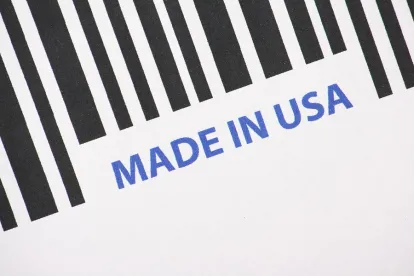The Trump administration promises to streamline the regulatory process, dismantle burdensome regulations, and promote domestic job growth. On January 24, 2017, President Trump issued an executive order and four presidential memoranda seeking to advance these goals in the energy sector. The President directed specified Cabinet members and agencies to remove regulatory barriers to infrastructure investments and ordered the use of American-made materials to construct pipelines within the United States.
Nonetheless, hurdles remain for energy infrastructure projects the Trump administration seeks to accelerate, including natural gas and oil pipelines, storage facilities, and liquefied natural gas (“LNG”) export terminals. For example, the construction and operation of natural gas infrastructure facilities must be approved by the Federal Energy Regulatory Commission (“FERC”). However, FERC is currently operating without a quorum. The resources of staff in FERC’s Office of Energy Projects are limited, and there is in place a hiring freeze on all federal agencies. Both natural gas and oil infrastructure projects are also increasingly being challenged by environmental groups under the National Environmental Policy Act.
After summarizing the Trump administration’s recent energy-related executive orders and related actions to accelerate review of proposed energy infrastructure, this piece reviews ongoing challenges faced by natural gas and oil projects.
Trump Administration Executive Orders and Memoranda
A. Executive Order Expediting Environmental Reviews and Approvals for High-Priority Infrastructure Projects
This executive order emphasizes the importance of “maximum efficiency and effectiveness” in making federal infrastructure decisions and articulates the executive branch’s policy of streamlining and expediting environmental reviews and approvals for infrastructure projects – particularly high-priority projects such as, among other things, repairing and upgrading pipelines. The order sets forth the process for identifying high-priority projects for fast-track review. Upon the request of a state governor, agency head, or the Chairman of the White House Council on Environmental Quality (CEQ), the CEQ Chairman must decide within 30 days of the request whether an infrastructure project qualifies as “high priority.” In making this decision, the Chairman should consider certain factors, including “the project’s importance to the general welfare.”1 With respect to any project designated as a high priority, “the Chairman of the CEQ shall coordinate with the head of the relevant agency to establish, in a manner consistent with law, expedited procedures and deadlines for completion of environmental reviews and approvals for such projects. All agencies shall give highest priority to completing such reviews and approvals by the established deadlines using all necessary and appropriate means.” At the signing ceremony on January 24, President Trump stated: “If we’re going to fix our country, our bridges, our roadways, we can’t be in an environmental process for 15 years if a bridge is going to be falling down, or if a highway is crumbling. So we’re expediting environmental reviews and approvals.”2
Along with this Executive Order, President Trump issued four Presidential memoranda.
1. Presidential Memoranda Regarding Dakota Access Pipeline and Keystone XL Pipeline
President Trump issued two presidential memoranda to expedite construction of the Dakota Access Pipeline (“DAPL”)3 and Keystone XL Pipeline,4 both of which are crude oil pipelines.
In his memorandum on the DAPL, President Trump instructs the Assistant Secretary of the Army for Civil Works and the U.S. Army Corps of Engineers to, among other things: (1) review and approve, in an expedited manner, requests to construct and operate the DAPL; (2) consider withdrawing the Notice of Intent to Prepare an Environmental Impact Statement related to the controversial Lake Oahe water crossing (the U.S. Army Corps of Engineers has since granted DAPL an easement over federal lands), and (3) consider whether the 2016 Environmental Assessment, as well as prior reviews and determinations to date, satisfies legal and interagency consultation requirements.
The presidential memorandum regarding the Keystone XL Pipeline directs TransCanada to re-submit its application for a presidential permit to construct and operate the pipeline. It instructed the Secretary of State to reach a final permitting decision within 60 days of receiving the re-submitted application and to consider the Final Supplemental Environmental Impact Statement, issued in January 2014, as satisfying all applicable environmental concerns. In addition, the Secretaries of the Army and Interior, as well as the Directors of the Bureau of Land Management and the U.S. Fish and Wildlife Service, are ordered to issue specified authorizations to expedite the process. TransCanada re-submitted its permit application two days later and a final decision is due by March 27, 2017.5
2. Presidential Memorandum Regarding Construction of American Pipelines
President Trump also signed a presidential memorandum directing the Secretary of Commerce to develop a plan within 180 days requiring all new, retrofitted, repaired, and expanded pipelines within the United States to use American-made materials “to the maximum extent possible and to the extent permitted by law.” The memorandum defines “produced in the United States” to mean “[w]ith regard to iron or steel products, that all manufacturing processes for such iron or steel products, from the initial melting stage through the application of coatings, occurred in the United States.” Steel or iron material or products manufactured abroad from semi-finished steel or iron from the United States and steel or iron material or products manufactured in the United States from semi-finished steel or iron of foreign origin are not “produced in the United States” for purposes of the memorandum.6
Upon signing the memorandum, President Trump told reporters: “From now on, we’re going to be making pipeline in the United States. We build the pipelines, we want to build the pipe. We’re going to put a lot of workers, a lot of skilled workers, back to work.”7 President Trump has continued to reiterate these competing aims. In his recent remarks before the Conservative Political Action Conference (“CPAC”), Trump stated that his administration is “going to put the regulation industry out of work and out of business.”8 Meanwhile, speaking at a retreat for Republican lawmakers two days after signing the memorandum, Trump cautioned that “[i]f people want to build pipelines on our land, we want the pipe to be . . . manufactured here.”9 Moreover, at a January 30, 2017 small business roundtable at the White House, Trump stated that “[i]f we’re going to use our powers of eminent domain and all the other powers, then I want the pipe to be manufactured with United States Steel.”10 And in his remarks at CPAC, President Trump explained that his administration has “authorized the construction, one day, of the Keystone and Dakota Access pipelines. And issued a new rule. This took place while I was getting ready to sign. I said, who makes the pipes for the pipeline? Well, sir, it comes from all over the world, isn’t that wonderful? I said, nope, it comes from the United States or we’re not building one. American steel. If they want a pipeline in the United States, they’re going to use pipe that’s made in the United States, do we agree?”11
3. Presidential Memorandum Streamlining Permitting and Reducing Regulatory Burdens for Domestic Manufacturing
In an accompanying presidential memorandum, titled “Streamlining Permitting and Reducing Regulatory Burdens for Domestic Manufacturing,” President Trump directs executive departments and agencies to “reduce regulatory burdens affecting domestic manufacturing.”12 At the signing ceremony on January 24, 2017, President Trump stated that this memorandum would streamline “the incredibly cumbersome, long, horrible permitting process.”13 In it, he orders the Secretary of Commerce to solicit comments, through a 60-day comment period, on how to streamline permitting and reduce regulatory burdens. Within 60 days of the close of the comment period, and after coordinating with specified agency heads, the Secretary must submit to the President a report describing recommended changes to the existing regulations and actions that may be taken immediately under existing authority.
B. Executive Orders on Reducing Regulation and Controlling Regulatory Costs and on Enforcing the Regulatory Reform Agenda
President Trump has subsequently issued two executive orders seeking to reform the regulatory process more generally.
In a January 30, 2017 Executive Order on Reducing Regulation and Controlling Regulatory Costs, he mandates that for every new regulation issued, at least two existing regulations must be identified for elimination. In addition, the order instructs the heads of all agencies that the total incremental cost for all new regulations for fiscal year 2017 will not exceed zero. Agency heads must provide their agencies’ best estimate of the total costs or savings associated with each new regulation or repealed regulation.14
In a February 24, 2017 Executive Order on Enforcing the Regulatory Reform Agenda, he instructs the head of each agency to designate an agency official as its Regulatory Reform Officer (“RRO”) to supervise the implementation of regulatory reform initiatives to ensure that agencies undergo reforms. In addition, each agency is directed to create a Regulatory Reform Task Force comprised of the agency RRO and other specified individuals to analyze existing regulations and identify those that (1) eliminate jobs; (2) are outdated or ineffective; (3) impose costs exceeding any benefits, and (4) conflict with regulatory reform policies and initiatives. Within 90 days of the order’s issuance, each task force must submit a report to the agency head detailing its progress and recommending which regulations should be repealed, replaced, or modified.15
Analysis
Natural gas and oil infrastructure projects are subject to different types of regulatory review at the federal level. The more comprehensive and coordinated review applies to natural gas projects. Under sections 7 and 3 of the Natural Gas Act (“NGA”), FERC reviews proposed natural gas infrastructure and coordinates the environmental review of such projects under the National Environmental Policy Act (“NEPA”). Natural gas projects are reviewed by FERC’s Office of Energy Projects, and the Division of Gas Environmental and Engineering within the Office is tasked with preparing an analysis under NEPA. Under the NGA, FERC must determine whether a project is in the public interest, although the test is somewhat different under each section.
No single or coordinating federal agency reviews proposed oil infrastructure in the same manner that FERC reviews natural gas facilities.
Both natural gas and oil projects may require issue-specific federal authorizations from or consultations with other federal agencies such as the Department of State, the U.S. Army Corps of Engineers, the U.S. Coast Guard, the Department of Energy, the Department of the Interior, the Bureau of Land Management, the Environmental Protection Agency, and the U.S. Fish and Wildlife Service. In such cases, an environmental review under NEPA is also likely to be required. Natural gas and oil projects may also require authorization under the federal Clean Air Act and Clean Water Act, which are implemented by state agencies.
Challenges remain for the rapid approval of natural gas and oil projects, notwithstanding the new Administration’s stated objectives. First, as to natural gas projects, the most immediate problem is that FERC is currently without a quorum. FERC is a five-member, independent commission with no more than three commissioners from one political party, and FERC commissioners must be approved by the Senate. With the departure of the former chairman on February 3, 2017, FERC currently has only two Commissioners, Acting Chairman Cheryl A. LaFleur and Commissioner Colette D. Honorable. Without a quorum, FERC cannot approve contested natural gas infrastructure applications, and virtually all such applications have been opposed by environmental groups in recent years. There has been speculation that the Trump administration is actively looking for commissioners to fill one or more of the three empty slots, perhaps as soon as early March. In the meantime, projects that had not been approved on or before February 3, 2017, are postponed indefinitely, although FERC staff is certainly continuing to work on such applications to be ready for when FERC is operating with a quorum.
Second, the current number of FERC staff are limited in the number of projects they can process. A new natural gas project can take anywhere from 15 to 30 months to be approved from start to finish, depending on the type of project. Much of this time is spent preparing the NEPA documents and reviewing environmental comments filed by stakeholders under the NEPA. However, the Trump administration has imposed a hiring freeze on all federal agencies although exceptions may be granted in some circumstances.16 If the Trump administration seeks to accelerate review and approval of natural gas projects, it may have to increase the number of FERC staff working on such projects.
Third, the Trump administration’s actions do not generally modify the requirements of the National Environmental Policy Act, which applies to both natural gas and oil projects, and environmental groups and others have been increasingly aggressive in challenging FERC’s and other federal agencies’ authorization orders on the ground that they do not comply with NEPA. NEPA requires federal agencies to assess the environmental effects of their proposed actions, such as issuing authorizations under the NGA and other federal statutes. As mentioned above, the NEPA review is a substantial part of FERC’s review of natural gas projects. The review culminates in FERC staff issuing an environmental impact statement or, in limited circumstances, an environmental assessment, prior to FERC’s issuance of its order under section 7 or 3 of the NGA. FERC is considered the “lead agency” for purposes of environmental review.17 As the lead agency, FERC is expected to set an expeditious schedule for all federal agencies and state agencies acting under federal delegated authority to reach a final decision on requests for federal authorizations necessary for the proposed project. FERC has a NEPA pre-filing process that allows for the early input of stakeholders. There are also opportunities after the application is filed for persons or groups to intervene and provide comments on the environmental review. Environmental groups and others have been litigating authorization orders, arguing that FERC and other federal agencies, such as the Department of Energy, which handles natural gas export applications, have failed to account for indirect and cumulative effects of increased natural gas production, which they allege results from approval of these projects. Appeals of FERC and other federal agency decisions are currently pending in the U.S. Courts of Appeals.18 None of the Trump administration’s actions are directed at these challenges.
Finally, the Trump administration’s own actions may serve to delay natural gas infrastructure projects or make them more expensive. The American-made directive raises uncertainty regarding the requirements for construction. TransCanada already has purchased a significant amount of non-American materials to construct Keystone XL, while Energy Transfer Partners has built all but a small portion of the DAPL. While the White House has stated that the requirement only applies to “new pipelines or those that are being repaired” and that Keystone XL Pipeline is exempt,19 the memorandum’s applicability to other pipelines remains unclear.
A recent report noted the “somewhat counterintuitive move” of requiring American-made materials to construct American pipelines in one memorandum while simultaneously seeking to remove barriers to infrastructure development in other memoranda. It argued: “mandating that an industry use products from one country raises the cost of every project by limiting the supply, gives monopoly power to domestic producers and allows suppliers to abandon the pricing discipline that competition creates.” A spokesperson for the Association of Oil Pipe Lines stated that pipeline materials assembled in the United States generally contain both U.S. and foreign parts due to its focus on materials meeting quality and safety requirements.20
It remains unclear whether the U.S. steel industry has the capacity to supply all new projects going forward in the United States.21
As noted in a few publications, this Presidential memorandum does not clarify whether these requirements apply to offshore or cross-border pipelines, nor how the administration will effectuate the directive without violating existing international trade agreements.22 Key language in the memorandum, requiring American-made materials “to the maximum extent possible and to the extent permitted by law,” may provide a loophole.23 Commenters also suggest that this phrase avoids running afoul of existing trade treaties.24
One of the centerpieces of the Trump administration is a renewed focus on infrastructure, and the administration’s actions in the energy sector seek to further those goals. Nevertheless, hurdles remain, including agency staffing limitations, environmental litigation, and the administration’s own American-made requirement.
1 Executive Order Expediting Environmental Reviews and Approvals For High Priority Infrastructure Projects (Jan. 24, 2017), available at https://www.whitehouse.gov/the-press-office/2017/01/24/executive-order-expediting-environmental-reviews-and-approvals-high.
2 See Susan Jones, CBSNews.com, “Trump on Keystone: ‘We’ll See If We Can Get That Pipeline Built’ – With USA-Made Pipe,” http://www.cnsnews.com/news/article/susan-jones/trump-keystone-well-see-if-we-can-get-pipeline-built-usa-made-pipe.
3 Presidential Memorandum Regarding Construction of the Dakota Access Pipeline (Jan. 24, 2017), available at https://www.whitehouse.gov/the-press-office/2017/01/24/presidential-memorandum-regarding-construction-dakota-access-pipeline.
4 Presidential Memorandum Regarding Construction of the Keystone XL Pipeline (Jan. 24, 2017), available at https://www.whitehouse.gov/the-press-office/2017/01/24/presidential-memorandum-regarding-construction-keystone-xl-pipeline.
5 TransCanada NewsRelease, “TransCanada Applies for Keystone XL Presidential Permit” (Jan. 26, 2017), available at http://transcanada.mwnewsroom.com/Files/d8/d80ffdd4-cc60-4971-bb01-c22c1b8d4a1c.pdf.
6 Presidential Memorandum Regarding Construction of American Pipelines (Jan. 24, 2017), available at https://www.whitehouse.gov/the-press-office/2017/01/24/presidential-memorandum-regarding-construction-american-pipelines.
7 Steven Mufson & Juliet Eilperin, Washington Post, “Trump seeks to revive Dakota Access, Keystone XL oil pipelines,” available at https://www.washingtonpost.com/news/energy-environment/wp/2017/01/24/trump-gives-green-light-to-dakota-access-keystone-xl-oil-pipelines/?utm_term=.5db67ba67316.
8 Remarks by President Trump at the Conservative Political Action Conference (Feb. 24, 2017), available at https://www.whitehouse.gov/the-press-office/2017/02/24/remarks-president-trump-conservative-political-action-conference.
9 Tom DiChristopher, CNBC, “Donald Trump increases pressure on pipeline makers, his latest industry target” (Jan. 30, 2017), available at http://www.cnbc.com/2017/01/26/trumps-plan-to-force-pipeline-makers-to-use-us-steel-is-dictatorial-and-a-bad-idea.html.
10 Id.
11 Remarks by President Trump at the Conservative Political Action Conference (Feb. 24, 2017), available at https://www.whitehouse.gov/the-press-office/2017/02/24/remarks-president-trump-conservative-political-action-conference.
12 Presidential Memorandum Streamlining Permitting and Reducing Regulatory Burdens for Domestic Manufacturing (Jan. 24, 2017), available at https://www.whitehouse.gov/the-press-office/2017/01/24/presidential-memorandum-streamlining-permitting-and-reducing-regulatory.
13 Jones.
14 Presidential Executive Order on Reducing Regulation and Controlling Regulatory Costs (Jan. 30, 2017) https://www.whitehouse.gov/the-press-office/2017/01/30/presidential-executive-order-reducing-regulation-and-controlling.
15 Presidential Executive Order on Enforcing the Regulatory Reform Agenda (Feb. 24, 2017), available at https://www.whitehouse.gov/the-press-office/2017/02/24/presidential-executive-order-enforcing-regulatory-reform-agenda.
16 Presidential Memorandum Regarding the Hiring Freeze (Jan. 23, 2017), available at https://www.whitehouse.gov/the-press-office/2017/01/23/presidential-memorandum-regarding-hiring-freeze.
17 Regulations Implementing the Energy Policy Act of 2005; Coordinating the Processing of Federal Authorizations for Applications under Sections 3 and 7 of the Natural Gas Act and Maintaining a Complete Consolidated Record, 117 FERC ¶ 61,076 (2006).
18 See Catskill Mountainkeeper Inc. et al. v. FERC, 2d Cir. Nos. 16-345 & 16-361; Sierra Club v. DOE, D.C. Cir. No. 15-1489.
19 Reuters, “Keystone XL builders can use non-U.S. steel, White House says now” (Mar. 3, 2017), available at http://www.reuters.com/article/us-transcanada-keystone-steel-idUSKBN16A2FC.
20 See DiChristopher.
21 See Kimberly VanWyhe, Executive Orders and Presidential Memorandums: Energy (Feb. 7, 2017), available at https://www.americanactionforum.org/research/executive-orders-presidential-memorandums-energy/.
22 See, e.g., Rapid Pace of Presidential Memoranda, Executive Orders Spells Opportunities and Challenges for Pipeline Industry, available at https://www.natlawreview.com/article/rapid-pace-presidential-memoranda-executive-orders-spells-opportunities-and.
23 See DiChristopher.
24 See id.






 />i
/>i

